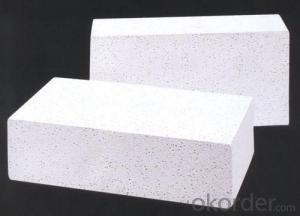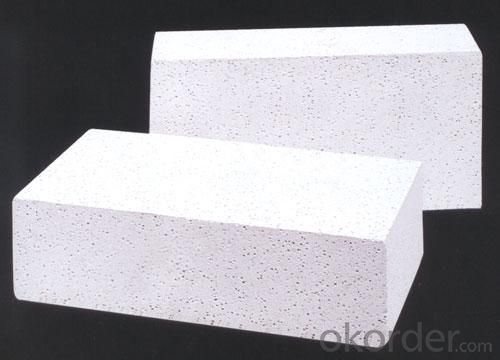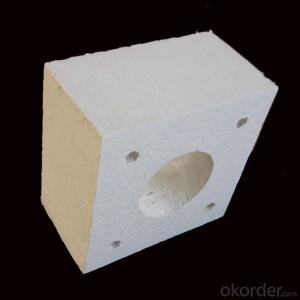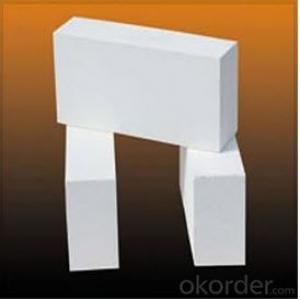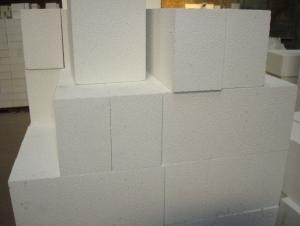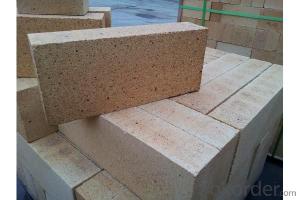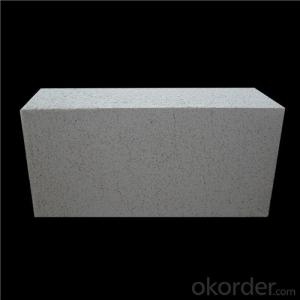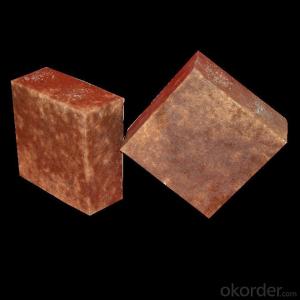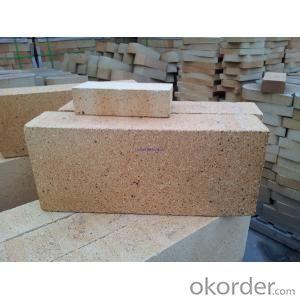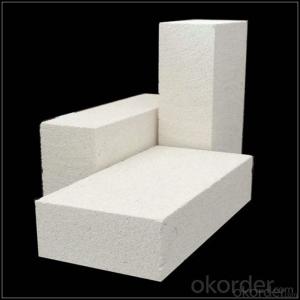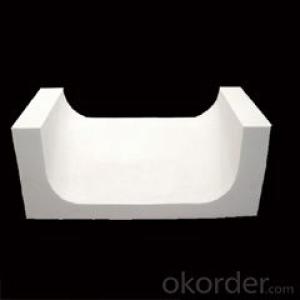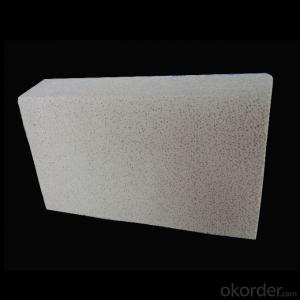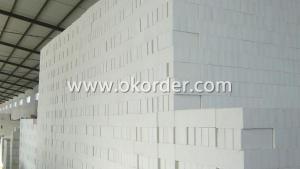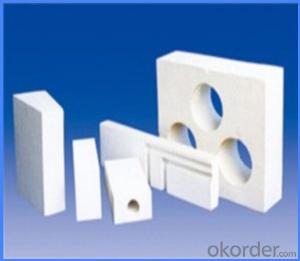Insulating Fire Brick for Steel Ladle Refractory Insulation
- Loading Port:
- Shanghai
- Payment Terms:
- TT OR LC
- Min Order Qty:
- 500 m.t.
- Supply Capability:
- 1000 m.t./month
OKorder Service Pledge
OKorder Financial Service
You Might Also Like
1.With high strength, high refractoriness, strong erosion resistance.
2.Can be customized according to customer's drawings for production.
3.The well block is suite with the nozzle , it can use in the steel making and the foundry,the tundish and ladle all can use it.The well block has long service life, no crack and no leak.
4. The well block use main the material with the high content of carbon and almnium or the zirconic.
5.We can produce the different shape according to the requirement of the client.
Refractory brick can be divided into three process: Raw material, molding, burning.Generally, refractory brick was molded by dry pressing. By means of mixing the material uniformity in proportion and aging mixture some time. Then, pour some powders into the module and dry pressing. After dry pressing, the adobe need to pushed in the drying kiln to stoving or stay in the air to drying. This progress will need about 3-5 days. After this progress, then push the adobe into the tunnel furnace or shuttle kiln to burning around 1300C. This progress will be need about 5-7 days.
After burning, the brick will be packed in pallet and leave the factory.
Item | Refractory Brick |
Applications | • Industrial furnace, glass furnace. • Chemical industrial furnace • Utility industry furnace lining. • Heat insulation ventilation wall. |
Features | • Resistance to High temperature, Resistance to erosion, resistance to abrasion • Excellent compression strength • Resistance to acid and alkali. • Excellent heat stability. |
- Q: How do insulating fire bricks affect the overall insulation efficiency of a process?
- The overall insulation efficiency of a process can be greatly enhanced by the use of insulating fire bricks. These bricks are specifically designed to have low thermal conductivity, making them excellent at resisting heat transfer. This property helps to minimize heat energy loss and maintain a consistent and controlled temperature within the process. The utilization of insulating fire bricks results in a significant reduction in the amount of heat that escapes from the process. This leads to improved energy conservation and ultimately, increased insulation efficiency. The bricks act as a barrier, preventing the conduction of heat through the walls, floors, or other components of the process equipment. This is particularly crucial in high-temperature applications, where heat loss can be substantial. Moreover, insulating fire bricks are capable of withstanding high temperatures without deteriorating or melting. This means that they can effectively insulate the process even when exposed to extreme heat conditions. Their durability ensures long-lasting performance and reliable insulation over time. Another advantage of insulating fire bricks is their lightweight nature. In comparison to traditional dense bricks, they have a lower density, which reduces the overall weight of the equipment or structure. This not only simplifies the construction process but also minimizes the load on supporting structures. In conclusion, insulating fire bricks enhance the overall insulation efficiency of a process by reducing heat loss, maintaining a controlled temperature, and providing long-lasting insulation capabilities. Their low thermal conductivity, resistance to high temperatures, and lightweight properties make them an ideal choice for various industrial applications where energy conservation and efficient insulation are crucial.
- Q: Can insulating fire bricks be used in applications involving molten metal?
- Insulating fire bricks offer a viable option for applications utilizing molten metal. Crafted from lightweight refractory materials possessing exceptional thermal insulation properties, these bricks effectively endure high temperatures and deliver insulation and heat transfer protection. In scenarios involving molten metal, insulating fire bricks can serve as linings in furnaces, crucibles, and other equipment, effectively preventing heat loss and maintaining the desired temperature. Additionally, they function as a barrier between the molten metal and structural components, effectively averting damage or contamination. Nevertheless, it is crucial to acknowledge that the appropriateness of insulating fire bricks for a particular molten metal application hinges on factors such as temperature, metal type, and specific process requirements.
- Q: Can insulating fire bricks be used as a structural material?
- No, insulating fire bricks are not typically used as a structural material. They are mainly employed for their high thermal insulation properties and are not designed to bear significant structural loads.
- Q: Are insulating fire bricks resistant to cracking under pressure?
- Insulating fire bricks exhibit resistance to cracking when subjected to pressure. They are specifically engineered to endure elevated temperatures and mechanical strain. Composed of lightweight materials with low thermal conductivity, like ceramic fiber or lightweight aggregates, these bricks maintain their structural integrity even under pressure or thermal expansion. Moreover, insulating fire bricks typically possess a significant alumina content, enhancing their strength and crack resistance. These qualities make them an excellent choice for applications requiring insulation and structural stability, such as furnaces, kilns, and high-temperature industrial processes. Nevertheless, it is crucial to acknowledge that excessive pressure or abrupt temperature changes can still harm insulating fire bricks. Thus, it is essential to adhere to proper installation and maintenance guidelines to ensure their durability and performance.
- Q: Can insulating fire bricks be used in the construction of melting furnaces?
- Insulating fire bricks can indeed be utilized in the construction of melting furnaces. These bricks are specifically designed to withstand high temperatures while possessing excellent thermal conductivity. Their primary purpose is to minimize heat loss and conserve energy, rendering them highly suitable for melting furnaces. Additionally, these bricks are lightweight and easily manageable, providing convenience during construction. They are also capable of effectively retaining heat and maintaining a steady furnace temperature, thus ensuring efficient melting and casting processes. Moreover, insulating fire bricks exhibit resistance to chemical corrosion and mechanical stress, showcasing their durability and reliability for long-term use in melting furnaces. In conclusion, considering their thermal properties, ease of use, and durability, insulating fire bricks are a fitting choice for constructing melting furnaces.
- Q: Can insulating fire bricks be used in refractory linings for blast furnaces?
- Yes, refractory linings for blast furnaces can utilize insulating fire bricks. These bricks are specifically designed to possess low thermal conductivity, effectively minimizing heat loss from the furnace. This characteristic holds particular significance in blast furnaces where maintaining high temperatures is crucial for optimal operation. Insulating fire bricks are crafted from lightweight refractory materials like alumina or silica, renowned for their exceptional insulating properties. These bricks not only provide thermal insulation, but they also exhibit remarkable resistance to thermal shock, rendering them suitable for the extreme conditions prevalent in blast furnaces. Beyond insulation, insulating fire bricks present additional advantages for blast furnace linings. They possess a lightweight nature and are easily installable, thereby reducing construction labor and time requirements. Moreover, their low thermal conductivity aids in minimizing the occurrence of hot spots and uneven temperature distribution within the furnace. These issues, if unaddressed, can trigger premature wear and failure of the refractory lining. However, it is crucial to acknowledge that relying solely on insulating fire bricks may not suffice for all portions of the blast furnace lining. Certain areas, such as the hearth and tuyere zones, may necessitate high-density refractory bricks capable of withstanding intense heat and mechanical stress. In such cases, a combination of insulating fire bricks and other refractory materials can be employed to achieve the desired performance and longevity. Overall, insulating fire bricks serve as a valuable constituent in refractory linings for blast furnaces, offering benefits such as enhanced energy efficiency, reduced heat loss, and prolonged lifespan of the lining.
- Q: Can insulating fire bricks be used in thermal power plants?
- Yes, insulating fire bricks can be used in thermal power plants. Insulating fire bricks are designed to provide thermal insulation and resist high temperatures, making them suitable for applications in thermal power plants. These bricks can be used in various areas of a power plant, such as in the lining of boilers, furnaces, and kilns, where they help to reduce heat loss and increase the overall energy efficiency of the plant. Additionally, insulating fire bricks are lightweight and have good thermal shock resistance, allowing them to withstand the extreme temperature fluctuations that occur in power plant operations.
- Q: Can insulating fire bricks be used in power plants?
- Indeed, power plants have the capability to utilize insulating fire bricks. These bricks, also referred to as refractory bricks, are specifically designed to endure extreme temperatures and offer exceptional thermal insulation. They find extensive usage in a wide range of industrial settings, including power plants. The combustion of fossil fuels or the process of nuclear fission within power plants generates a substantial amount of heat. In order to ensure efficient operations and prevent heat loss, power plants employ insulating fire bricks to line the walls, floors, and ceilings of furnaces, boilers, and other areas that experience high temperatures. Insulating fire bricks possess a low thermal conductivity, thereby effectively reducing heat transfer. This serves to conserve energy and enhance the overall efficiency of power plants. Furthermore, these bricks exhibit high resistance to thermal shock, enabling them to withstand abrupt temperature changes without sustaining any cracks or fractures. In addition, insulating fire bricks are lightweight and simple to install, making them an ideal choice for power plant applications. They also possess resistance to chemical corrosion, which is crucial in power plants where various gases and chemicals are present. To summarize, insulating fire bricks are an appropriate option for power plants due to their ability to endure high temperatures, offer exceptional thermal insulation, and resist thermal shock and chemical corrosion. Incorporating these bricks into power plant applications serves to enhance energy efficiency and maintain optimal operating conditions.
- Q: What is the typical bulk density of an insulating fire brick?
- The average bulk density of an insulating fire brick generally ranges from 0.6 to 1.2 grams per cubic centimeter (g/cm³). Nevertheless, it should be emphasized that the actual bulk density can differ based on the specific composition and manufacturing procedure of the insulating fire brick.
- Q: What are the different sizes and shapes available for insulating fire bricks?
- Insulating fire bricks come in various sizes and shapes to meet different insulation needs. Common sizes include standard, medium, and large, with dimensions ranging from 9" x 4.5" x 2.5" to 12" x 12" x 2". As for shapes, they are available in rectangular, square, and custom shapes like arches and wedges. The specific size and shape of the insulating fire brick depend on the requirements of the application and the manufacturer's offerings.
Send your message to us
Insulating Fire Brick for Steel Ladle Refractory Insulation
- Loading Port:
- Shanghai
- Payment Terms:
- TT OR LC
- Min Order Qty:
- 500 m.t.
- Supply Capability:
- 1000 m.t./month
OKorder Service Pledge
OKorder Financial Service
Similar products
Hot products
Hot Searches
Related keywords
